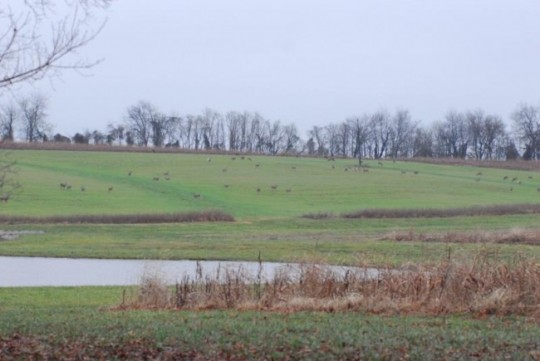Category: Deer Hunting
Pt. 2: Top 10 Recommendations for Managing Land to Yield Mature, Huntable Deer
Part 2: Nutrition
Last week I started addressing a question posted on my Facebook page about how to manage land to yield mature, huntable deer. The subject of that blog was how important age is to allowing bucks to express their antler growth potential. In addition, by allowing more bucks to mature, there will be more bucks to harvest – more bucks usually equates to better hunting.
However, there are lots of areas with a relatively high density of mature bucks, but very few bucks with good antler development. This often occurs in areas where hunting is not allowed and no habitat management activities occur. These areas include preserves, parks, etc. For bucks to express their genetic antler development potential, they must be allowed to 1) mature, 2) and have access to quality forage.
I remember visiting years ago with a wise gentleman when another person entered the conversation and shared an image of a very large buck recently harvested for that area. My friend instantly said “I bet that buck was harvested within a mile of one of the few soybean fields.” The gent with the image said “how’d you know?” My friend simply said, “All the big deer killed in this county are harvested by the soybean fields.”
My friend knew that big bucks are usually seen where the combines roam. His statement was not only correct for that county, but throughout the whitetails’ range. Compare the following maps. The first shows the distribution of soybeans grown throughout the continental states and the second shows the distribution of B&C and P&Y bucks harvested up to 2005. The correlation is not perfect, but it’s close enough to make the point.
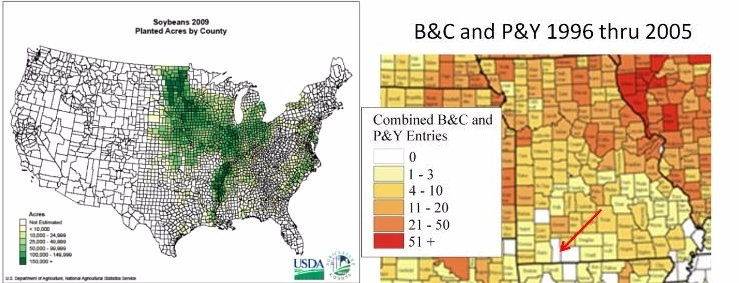
Planted soybean acres by county compared to big bucks by county.
The good news is that soil can be improved anywhere – even if the land you hunt is not shaded green on the soybean map. Notice that it’s a long way to any green on the map from where I live (Stone and Taney counties, MO). Even so, I grow great soybeans (and deer) using the combination of Eagle Seed beans, Antler Dirt fertilizer, and no-till drill techniques.
To have huntable mature bucks requires allowing bucks to mature and have access to good forage so they can express their antler growth potential. Good forage serves two purposes of allowing deer to express their potential and serving as an attractant so mature bucks can be patterned.
Insuring quality forage is available year round is #2 on my top 10 list of managing land to yield mature, huntable bucks.
Growing Deer together,
Grant
Pt. 1: Top 10 Recommendations for Managing Land to Yield Mature, Huntable Deer
Part 1: Age
Earlier this week I received a very good question on my Facebook page. Dan Dealy asked “Dr. Woods, what are your TOP TEN recommendations for managing land (and wildlife) to yield mature, huntable deer?”
One of the keys to Dan’s question was the second to last word –“huntable.” Most managers and hunters consider food, cover, and water, but they don’t consider how to make a property “huntable” or hunter friendly for mature bucks.
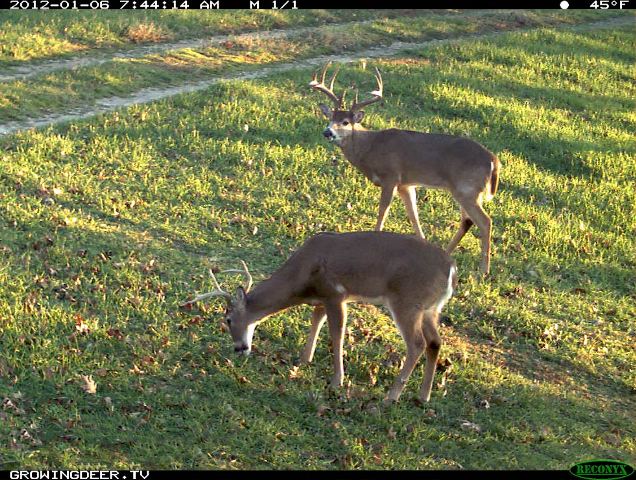
Last Lick Big 10 and Pumpkin Face
For a property to be huntable for mature bucks – for a hunter to have better than average odds of harvesting a mature buck – there are several factors that must be considered. To discuss all of these in detail would require a book (like Deer Management 101). In my next few blog posts, I will share some thoughts about my top ten recommendations to produce a huntable population of mature bucks. I apply these strategies and techniques to my property and have applied them to those of my clients for 20+ years. They are not deep secrets or magic recipes. They are proven and practical.
Having realistic expectations is the first step to satisfaction. It is important to understand that having huntable mature bucks doesn’t mean there will be Boone and Crocket class bucks behind every tree. A buck is mature to me when they are 4 years old or older. This is when bucks grow the largest antlers because most of their skeletal development is complete and they can use most of their excess resources to produce the biggest antlers of their genetic potential. Few free-ranging bucks express their genetic potential. In my opinion, many hunters, writers, etc., waste way too much time talking about whitetail genetics.
First, it’s very difficult to alter the gene pool of a free-ranging herd of whitetails. Second, there is probably nothing wrong with the genetics, but ample room for improvement of the habitat and herd structure.
With that said, my number one factor to improve the yield of huntable mature bucks is to have more mature bucks. To get more mature bucks, immature bucks must be passed and allowed to grow. Rule #1 the in Woods’ Book of Deer Management is that “Dead Deer Don’t Grow.” It sounds simple, but some hunters still don’t understand. They harvest a good looking two year old buck and then complain that they never harvest a “monster buck.” They’ve probably harvested several monster bucks – they just shot them before they matured and were allowed to express their genetic potential to produce large antlers! Bucks typically produce larger antlers as they age. University research shows that two and three year old bucks produce on average about 50 and 75% of their antler growth potential. It’s not until bucks mature to four years old that they express, on average, about 94% of their antler growth potential. To have an opportunity to harvest mature bucks, you must hunt where bucks are allowed to mature. That’s #1 in my top 10 recommendations for managing land to produce huntable mature bucks. The more bucks that are allowed to live to 4+ years of age, the easier it will be to harvest a mature buck. I’d much rather hunt a property that has three mature bucks per square mile than one or no mature bucks per square mile.
The least expensive form of deer management is trigger finger management. It simply costs less to pass immature bucks than any other form of management for establishing a hunter friendly population of mature bucks.
During 2012 – if you want to tag a mature buck, be prepared to pass immature bucks. Yes, others in your area may kill immature bucks. However, the trend must start somewhere and it is most likely to start with you. Share the education with other hunters in your area. You don’t have to convince all of them, but you won’t convince any of them when gathered around an immature buck you just harvested.
Remember, the first rule of deer management – “Dead Deer Don’t Grow.”
Growing (huntable mature bucks) Deer together,
Grant
When Bucks Grow the Largest Antlers
Ben Hampton, Prostaff on Midwest Whitetail, recently shared the pictures of this super buck with me. He found the buck’s sheds last year and they grossed 154 4/8 (172 4/8 with an 18′ spread) as a typical 6×6 and this year he grossed 174 3/8 as a 6×5, with an additional 10 non-typical points he didn’t have last year, for a total gross non-typical score of 191 6/8. Ben asked me if it was typical for a deer to make this big of jump between 5 and 6 and if the bad drought they experienced in the summer of 2010 could have suppressed last year’s rack.
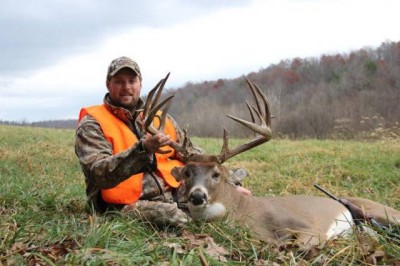
21 point buck harvested by Ben Hampton
Bucks, just like humans, are individuals. Some bucks produce larger antlers earlier than others. I was the tallest kid in 1st grade. Folks wanted me on their basketball team. By the time I was in high school, I didn’t make the team. Some bucks grow early, some mature late.
On average (averages represent populations – but almost never an individual) bucks express 94% of their antler growth potential by age 4.5. However, most wild deer don’t have access to quality forage year round. There have been bucks in research locations that barely scored 120 and then blew up to 200+ once given a better diet.
By being allowed to mature and having access to better forage created a perfect scenario for the buck Ben harvested to express his full antler potential. His timing was perfect.
So – in general, the better the year round forage, the later in life bucks will express their full antler growth potential.
Congratulations Ben, that’s a fabulous buck!
Growing Deer together,
Grant
How Weather Conditions Affect Hunting
It’s warmer than normal across most of the whitetails’ range. Warm weather during January is usually associated with swirling winds. Looking at the weather forecast below, the wind direction will go around the compass during the next day or so at my place. That makes hunting conditions tough.
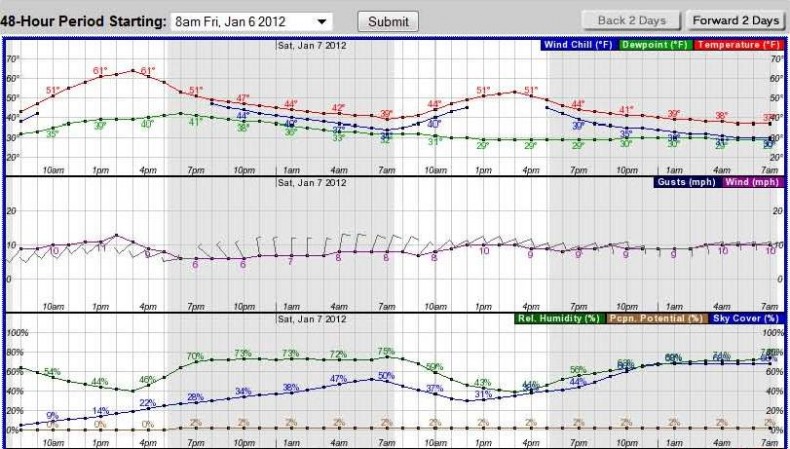
Hourly temperature prediction chart
However, that’s not the only ramification of warmer than normal temperatures this time of year to a deer hunter and manager. At this point in the season deer have a full fur coat. It was created to retain heat during extremely cold conditions for the area where those deer live (this is one reason deer shouldn’t be transported to new areas with different climatic conditions as they may not be adapted to thrive in the different conditions).
I don’t feel like moving much when I’m hot. Likewise, deer tend to limit their activity until the coolest times of the day when it’s hot relative to the normal conditions (60 in January when deer have a great fur coat probably makes them feel much hotter than when it’s 90 in July when they have a very thin summer coat). The coolest temperatures usually occur during nighttime. Hot temperatures during the late season encourage nocturnal activity. These factors make hunting deer very difficult during the late season when the temperatures are much warmer than normal for that time of year.
However, there are other considerations about warmer than normal temperatures during the winter. Deer ingest more food when they are colder – at least to a certain point. An exception is that if the temperatures get significantly colder than normal, deer tend to remain in cover and limit their activity.
Deer will produce larger antlers the following year if they consume more quality food (within limits) during the winter. It seems that warmer than normal temperatures probably result in deer consuming less food, and therefore potentially smaller antlers the following year.
I enjoyed walking to my stand yesterday without carrying bulky clothing. I never felt a chill the entire evening. Although I was comfortable, I would have gladly traded my comfort for colder temperatures and seeing deer during that hunt, and the hope of the local herd producing larger antlers and healthier fawns during 2012.
Slightly colder than normal temperatures during the late season probably result in better hunting, and healthier deer the following year. How are the weather conditions where you are hunting?
Growing Deer together,
Grant
Hunting Timber versus Row Crops
I’m returning from hunting in Kentucky as I write this. I hunted a friend’s property that is primarily timbered. Timbered means that much of the sun’s light doesn’t reach the ground during the growing season as it’s captured by the trees’ canopy. The lack of sun reaching the dirt means food production for deer (and many other forms of wildlife) is limited.
Limited food means limited numbers of deer compared to habitat types like row crops (corn and soybeans) or the prairie. In these areas most of the sun’s light (energy) reaches the dirt or at least the crop’s canopy which is within a deer’s reach most of the year. More food, more deer. I like hunting where there are more deer (I call that a target rich environment!).
Another advantage of hunting in row crop or prairie areas is visibility. Less than 20 miles from where I was hunting on the timbered property, I toured a corn and soybean (row crop) farm. It was a well managed farm with excellent crop production and cover strips for wildlife and erosion control. It was a great example of farming for profit while managing a percentage of the land primarily for wildlife (farming and wildlife can co-exist while profits are maintained). I counted more than 300 deer during a brief tour!
The weather, date, etc., was the same as while I was hunting on the timbered property. With three of us hunting, we saw fewer than 20 deer from the stand during three days of hunting.
I felt very confident I could have grabbed my bow and Muddy stand and harvested a good buck within a day or two at the grain production farm. It was very obvious where the deer were bedding and feeding, and where they were traveling from one to the other.
Many other folks have made this same observation. This is why hunters migrate annually to the row crop areas of the Midwest to hunt and most hunting shows are filmed there. It’s simply easier to pattern deer in areas where most of the land base is open and visible. In addition the cultivated crops are outstanding food for deer and allow them to express most of their genetic potential.
That’s not to say that hunting in the timber isn’t fun. My place is mostly timbered and I enjoy hunting there. However, I usually spend several months trying to pattern and harvest a buck. I can usually accomplish the same goal in much less time when hunting areas where row crops are the dominate habitat type.
I enjoy hunting anywhere – but know my chances for success are better where there’s lots of sunlight reaching the dirt!
Growing Deer together,
Grant
Hunt Mature Bucks with a Predictable Pattern
The second chase phase (the period of the rut after the lock down phase) is on or winding down in most parts of the whitetails’ range (excluding parts of Alabama, Florida, south Texas, etc.). This means a small percentage of adult does haven’t bred yet, and most of the yearling female fawns haven’t bred yet.
Bucks will be moving more searching for receptive does and for quality food resources. Likewise, does will begin moving a bit more as the intensity of the rut decreases as both does and bucks are seeking sources of quality food.
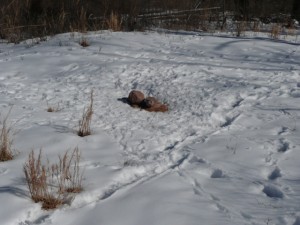
Deer tracks in snow near a Trophy Rock
The quantity and number of locations with quality food is decreasing with the winter temperatures, unless supplemental feed is used on the property you hunt. Therefore identifying the preferred feeding location for deer is becoming easier. That’s great news for hunters!
However, it doesn’t mean hunting is becoming easier. Hunting season has been in effect throughout most of the whitetails’ range for several months. Mature deer are very conditioned to avoiding hunters at this stage of the season. Therefore, identifying the preferred food source is only part of challenge.
Chasing deer that are experienced at avoiding hunters is no easy task. The leaves are mostly off hardwood trees so stands that offered great cover a month ago now leave the hunter wide open.
Good camo, especially on the face and hands (the parts of a hunter that move the most when they are in a stand) is a must. Remember that deer see movement much better than they see cover.
Deer may be conditioned to avoid some fields during daylight due to the amount of hunting in that location already during the season. If that’s the case, select a stand location between the bedding area and the field. Better yet, if practical avoid hunting some plots until the late season. Let deer become conditioned to feeding in an area without being disturbed by hunters. Those are dream locations during the late season. I often use an electric fence to protect small plots until the late season. These plots would have been totally consumed if not protected by the fence.
Finally, with the colder the temperatures, the more deer need to feed to maintain their body temperature. Colder temperatures usually result in deer feeding during daylight hours. Mature bucks will be feeding in the plots that haven’t had much hunting pressure and I plan on being there. The late season usually offers some of the most predictable deer activity throughout the entire season.
I ordered some heated insoles for my boots today. I’m hoping for some very cold days during the late hunting season. It’s worth getting a little cold to hunt mature bucks that have a predictable movement pattern to specific location.
Growing Deer together,
Grant
Hunting The Second Chase Phase of the Rut
Last week I wrote about the lockdown phase of the rut. That phase of the rut can be some tough hunting as mature bucks don’t travel much except when finished tending one doe and seeking another receptive doe. Does tend to remain receptive (in heat) for approximately 24-36 hours.
However, during the next few days whitetails throughout most of their range will enter the second chase phase of the 2011 rut. This occurs when most of the does have been bred and bucks are seeking a receptive doe after a few weeks of finding such a doe almost daily. A huge factor in the length of the lockdown phase at any location is the adult sex ratio.
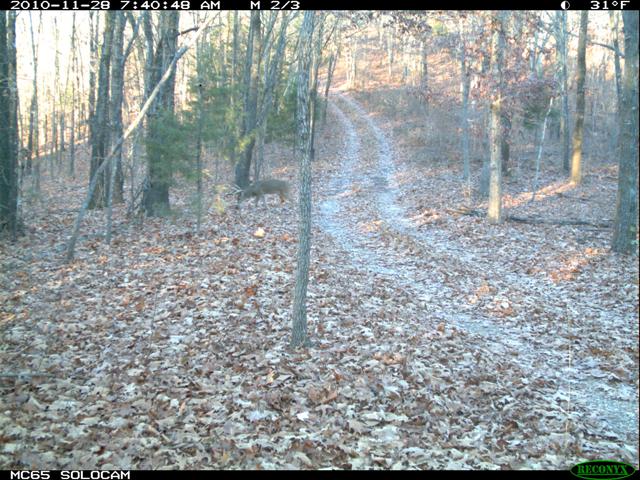
Buck during second chase phase of the rut
If the adult sex ratio favors does, then bucks don’t have to search as much or compete for receptive does. Some does won’t be bred during their first receptive cycle and will become receptive again in approximately 28 days. Often the phases of the rut in these herds are not well defined.
If the adult sex ratio favors bucks (can be accomplished in herds where more does are harvested than mature bucks), then the lockdown phase usually only lasts about two weeks and there is intense competition for the receptive does. The second chase phase in such herds can be almost as good as the pre breeding chase phase.
There are two factors that dampen the second chase phase. The first is some of the bucks have been killed by hunters, predators, suffered injuries from fighting, etc. There are simply less bucks to harvest during the second chase phase compared to the first.
The other factor is that bucks have now been pressured for several weeks. They are proven skilled at avoiding hunters if they are alive during the second chase phase. These bucks are not easy to pattern or kill.
However, there are some advantages to hunting the second chase phase. There is usually less food available during the second chase phase. Hence, identifying the food source is easier than during the early fall. Likewise the days are usually colder and deer need more calories. Therefore, they will spend more time feeding each day. This is when quality late winter season food plots can be great stand locations!
I’ll be using my Reconyx trail cameras to see which bucks on my hit list are still alive, and which food plots the does are using. Then, I’ll hunt the travel corridors or the actual plots that deer are feeding in frequently in an effort to tag another mature buck this year.
My strategy for the chase phase led to the harvest of Clean 12. I look forward to seeing if this strategy leads to the harvest of another mature buck.
Growing (and hunting) Deer together,
Grant
Lockdown Rut Phase
I grew up hearing and thinking the rut was the best time to hunt big bucks! Like most subjects, the more you learn, the more you use the terms “however,” “but,” and “if.” As I learned more about hunting and deer biology, the term “rut” got replaced with “pre-rut,” “the chase phase,” “lockdown,” and “post rut.” As I began understanding the facts and theories about these phases of the rut, I learned just how much site specific deer management impacts the behavior of local deer herds.
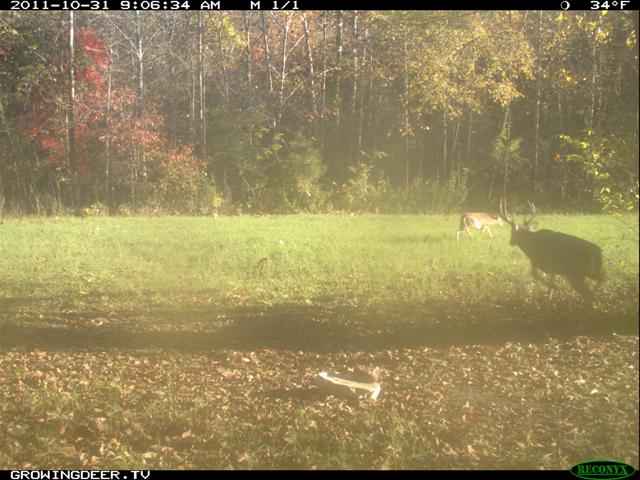
Big, mature buck chases a doe during chase phase of the rut.
I live and do most of my hunting in southwestern Missouri. In fact, I hunt primarily in Stone and Taney counties of Missouri. No matter where you hunt, herds with a higher number of mature bucks in combination with a balanced adult sex ratio usually provide better deer hunting. Bucks in these herds tend to respond to rattling, grunt calls, decoys, etc., better. There seems to be more activity during daylight hours (given the same weather conditions).
The best hunting is where a balanced adult sex ratio and older age structure exists among bucks for a large geographical area. The larger the area the better! However, the quality of hunting (as far as interacting with deer expressing all phases of the rut ) can be improved. Even on smaller acreages where deer ranges tend to overlap the property lines on neighbors that still practice “if it’s got horns, shoot it.”
In that scenario, the best hunting is usually during the later stages of the pre-rut or the chase phase of the rut. This is when bucks are searching for does, but the does are not receptive yet. Therefore, the bucks tend to be on their feet more hours throughout the day.
When a majority of the does are receptive, many of the bucks (young and old) will be paired up with a receptive doe for 24-36 hours. Often times a dominate buck will stay within 10 yards of a doe while subordinate bucks stay in the area trying to sneak in for a date. Does rarely move much in this situation, so the bucks don’t cover much ground either. When the peak of breeding is occurring, hunters are less likely to see deer.
I’ve heard from several of my hunting buddies from South Carolina to Kansas during the past few days and none of them are reporting seeing many deer. It appears many deer herds are currently in the lockdown phase of the rut.
I’ll keep hunting, but I’m looking forward to the post rut when once again just a few does are receptive and mature bucks are cruising trying to find a date and feeding. There’s another peak of mature buck activity coming and I’m eagerly waiting. I’ll share with you what I know from a hunter’s and scientist’s point of view next week.
Growing Deer Together,
Grant
The Chase Phase of the Rut
Mature bucks are beginning to chase does throughout much of the whitetail’s range. It’s a time of year that literally millions of deer hunters schedule their vacation and with good reason.
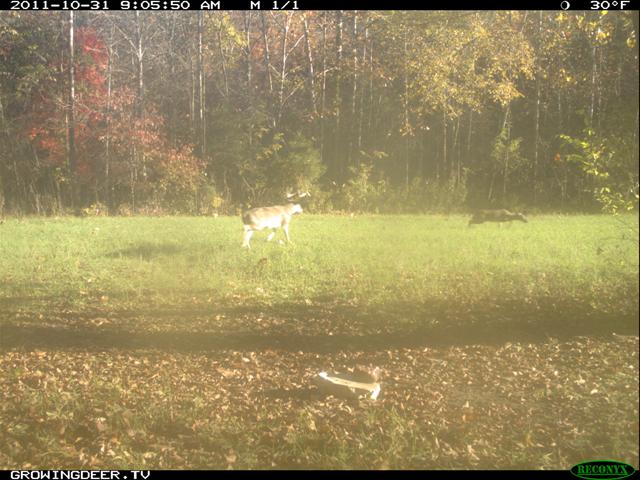
A big, mature buck chases a doe
If you hunt close to home, you can pick days to hunt when a weather front is passing, or you’ve found a limited resource such as a pond during drought that deer are actively using. However, if you are traveling to hunt then the chase phase allows you to plan a year in advance and puts the odds in your favor that mature bucks will be active during daylight hours. During the chase phase of the rut mature bucks tend to be active during the daytime even if the hunting pressure or air temperatures are a bit higher than normal.
The October Lull phase of deer activity just passed. This is when deer, especially mature bucks, have grown their winter coat and food is usually plentiful. Deer don’t have to travel far to find food, and they aren’t burning many calories to stay warm or chase does. Mature bucks simply don’t have many reasons to move during daylight in mid-October in most regions.
However, with each passing day now more and more does will become receptive. Bucks will be moving in search of the few does that are receptive. For the next several days, more and more does will become receptive until the peak of breeding activity. During the peak of breeding activity, most mature bucks will stay with a receptive doe for about 24 hours. This is called the Lock Down phase of the rut. During this time, mature bucks typically only move when they are finished tending one receptive doe and are seeking another.
The woods can seem almost void of deer during the Lock Down phase. This is because it’s not only the mature bucks that tend does. In fact, multiple research projects have now shown that mature bucks only breed slightly more does annually than immature bucks. Not many deer will be moving when most of the does are receptive and most of the bucks can have a date.
In addition, the duration and intensity of each phase of the rut varies location by location based on the herd’s adult sex ratio and health. Herds with a balanced (or skewed toward bucks) adult sex ratio seem to have the most intensive rutting behavior. There’s much more to the science than what I’ve shared here.
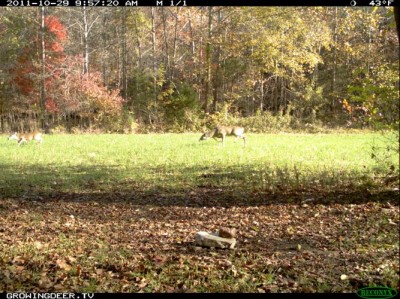
A Buck Chasing A Doe During The Chase Phase of the Rut
So, if you enjoy hunting the chase phase of the rut, get out the door! It’s time to go hunting! If you choose to plan ahead for your hunting vacation next year, the first and second week of November is usually a good option for hunting mature bucks in most areas of the whitetail’s range. There are other times of the year that can be very productive, but they are very weather dependent. The local weather can’t be predicted accurately enough to plan vacation time months ahead. However, weather isn’t as big of a factor during the chase phase of the rut, so it’s the safest bet for scheduling hunts that require packing a suitcase!
Growing Deer together,
Grant
It’s Time to Rattle!
The pre-rut is happening now throughout much of the whitetail’s range! My Reconyx cameras have taken more images of mature bucks during daylight hours during the past few days than any week since last fall! It’s prime hunting time!
Most does are not receptive yet. However the bucks are ready and eager for a date! They are actively seeking, and therefore very responsive to calls! Bucks may respond to calls at any time during the season, but they are most likely to respond during this stage of the rut.
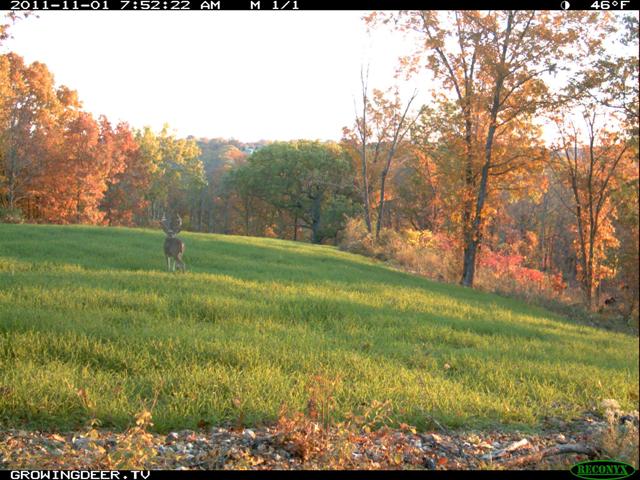
A grunt call is your best choice when a mature buck is nearby.
A fellow biologist and friend of mine, Dr. Mick Hellickson, is both a skilled hunter and researcher. Years ago he designed a study to determine how to rattle to get the most bucks to respond. He and his team tested four different rattling techniques in an area where several bucks were fitted with radio collars. They used the following sequences:
- Short duration and low volume
- Short duration and high volume
- Long duration and low volume
- Long duration and high volume
They had significantly more responses to the long duration and high volume sequence. This is easy to understand. Do you remember watching fights during school? If it was a relatively quiet scuffle between two freshmen, few folks even stopped to watch. Certainly no one even knew to run down the hall and watch.
However, if it was two seniors fighting to gain the attention of the prom queen, there was usually lots of yelling, lockers being rattled, grunts, and moans. It was so loud that most folks in the school ran to watch the fight. Even folks that were not involved with either party came to watch the fight!
The same is true when bucks fight. Yearlings tend to spar, scuffle, and not make many vocalizations when they “fight.” When you were a freshman in school and got into scuffle you probably didn’t want to draw the attention of a big senior or he might decide to settle both of the freshmen in the scuffle down.
However, when the big seniors got into a fight, part of the victory was knowing that everyone was watching!
When I rattle to call deer and no deer are in sight, I want to be a senior! I make as much rattling noise as I can!! I grunt or grunt snort wheeze. I then rattle making as much volume with the tool (antlers, rattle bag, etc.,) as I can. If practical and safe, I use my foot to shake a limb while I’m rattling. I want everyone in the school to know the big boys are fighting!
I don’t do this if I know there is a mature buck close by. This will likely alert him to my exact position. I use this type of calling technique when blind calling or calling when I don’t believe a deer is close by. If I do think a buck is close by, I will often simply grunt lightly and keep increasing the volume until the buck responds. I used the technique last week to call in Clean 12 – a buck that appeared he was going to pass by my stand at 70 yards and was headed to a bedding area (GDTV 101). A simple grunt resulted in Clean 12 making a scrape, rub, vocalizing a snort wheeze and approaching to within three yards of my stand.
Rattling is a great technique to attract mature bucks from a long distance. However, deer are very good at pinpointing the exact location of a call. Therefore they often will approach from the downwind side. This is why I don’t use the loud rattle sequence frequently. I want the buck to hear it once and come searching for the fight participants. I don’t want him to have the opportunity to hone in on the exact location.
My strategy on rattling is probably best summarized by a line in an old movie (I forgot the name of the movie) that goes “If you are going to be a bear, you might as well be a griz.” If you are going to rattle in hopes of calling in a buck when no deer are in view of the stand, make as much noise as you can. You want the bully buck in that area running in to see who is fighting on his turf.
Growing (and calling) Deer together,
Grant




